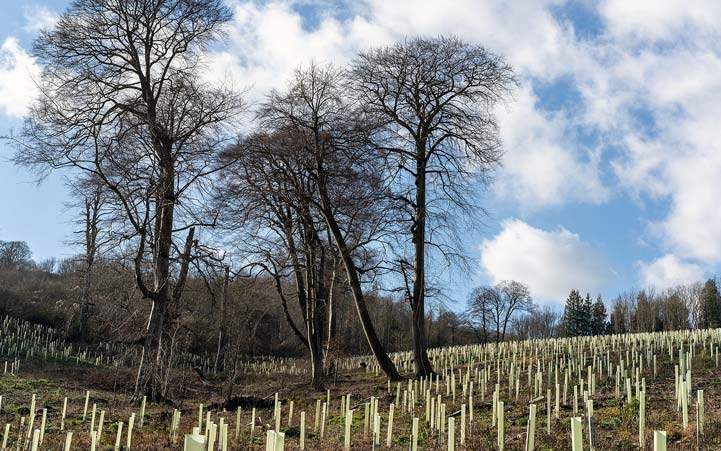The UK’s commitment to net zero emissions by 2050 has boosted interest in carbon offsetting markets and the regulation that underpins them. For rural land managers, increasing climate agenda action presents significant opportunities but also potential risks
Growth in the marketplace
The market for carbon investments and offsets has existed for over 15 years; however, the increased urgency of the climate agenda has boosted the interest in and relevance of the marketplace.
The carbon market consists of different carbon offsets, from nature-based ones such as forestry and peatland restoration to renewable energy, carbon capture and accelerating energy efficiencies. Carbon offsets are used to compensate for the residual emissions of a system, once other emissions reduction has been attempted.
The carbon market consists of multiple types of carbon offsets, from nature-based ones such as forestry and peatland restoration to renewable energy, carbon capture and accelerating energy efficiencies
Savills Rural Research
There are two types of carbon market: the compliance market and the voluntary market. The first is a regulated market, used by companies and governments that by law have to account for their greenhouse gas emissions. The EU Emissions Trading Scheme (ETS), established in 2005, is the largest compliance market, regulating specific industries through a cap and trade system. The EU ETS accounts for over 75% of international carbon trading and operates in 31 countries. The carbon price within the EU ETS for 2020 ranged from €15.24–€30.44/tCO2e. The compliance market faces substantial change due to the UK leaving the EU, and the voluntary market is evolving rapidly to take account of emerging corporate stakeholder expectations. This Market in Minutes covers recent developments in both.
What lies ahead in 2021
The UK is not only the first nation to have set a legal requirement to reach net zero emissions by 2050, but it is also, because of Brexit, the first country to leave the EU Emissions Trading Scheme (as of 1 January 2021). The UK is facing a substantial policy gap in achieving net zero by 2050, accentuated by the fact that it is on track to miss its fifth and sixth carbon budgets. This has triggered debate over how to reduce carbon emissions across the UK’s economy.
On 14 December 2020, the government published its Energy White Paper setting out how the UK will transition to net zero. Within this paper, the government has announced that it will establish a domestic UK Emissions Trading scheme to replace the EU ETS from 1 January 2021. The scheme is intended to provide a continuation of emissions trading for UK businesses; however, it will be the world’s first net zero carbon cap and trade market. According to the government, the scheme is more ambitious than the EU system it replaces – from day one the cap on emissions allowed within the system will be reduced by 5%.
The government has previously indicated that its preference is to link the UK ETS to the EU ETS. However, given the lack of progress in Brexit negotiations, it is unlikely that a link will be established in time for implementation. The government has hinted at linking the UK ETS to other international schemes, but no decision on preferred linking partners has been made. There has been criticism that a standalone UK ETS could face liquidity issues and may be vulnerable to volatility. The government has confirmed that the scheme is set to be implemented on time and has been designed jointly by all the devolved nations.

Carbon border tax?
There has been significant debate over whether the UK should implement a carbon border tax in order to bridge its net zero policy gap. A carbon border tax (also known as a carbon border adjustment) is a tax on carbon emissions attributed to imported goods that have not been carbon-taxed at source. It aims to achieve a level playing field between domestic and overseas industry – companies that export carbon-intensive products into a country would be subject to the same overall level of carbon taxation as domestic industries. This would prevent carbon leakage, whereby energy-intensive industries direct new investment overseas or leave the country to avoid emissions levies.
As part of its newly announced goal of cutting greenhouse gas emissions by 55% over the next decade, the EU is considering imposing a carbon border tax. President-Elect Joe Biden has also signalled interest in adopting a similar scheme for the US. Within the UK, there are proponents of a carbon tax and those who believe an ETS is more effective. However, COP26 climate finance advisor to government Ben Caldecott promotes a hybrid model that would see the UK adopt economy-wide taxes alongside the ETS. British economist Professor Dieter Helm agrees, suggesting the UK should gradually roll out a carbon tax after the standalone ETS has been up and running. There has been discussion over whether a carbon tax may be implemented in order to pay for the cost of the UK’s Covid-19 response instead of increasing income tax, National Insurance and VAT.
There are practicalities that mean implementing a carbon border tax on the agri-food sector would be difficult. The first hurdle is that policymakers would have to ensure that the tax is compliant with World Trade Organisation rules on global trade, in other words, it would have to be deemed a legitimate barrier to trade and not a cover for protectionism. Agriculture is a sector not currently under the EU ETS, meaning there is no standardised method for quantifying carbon impact. It is also important to remember that a large proportion of agricultural emissions derive from methane from livestock production. Whether a carbon border tax would regulate all greenhouse gas emissions depends on the extent of the final policy. It is hard to calculate the exact carbon “cost” of food imports that are often made up of many component parts, each under different carbon regulation regimes. Finally, a carbon border tax would be implemented nationally; however, it would also need to be able to account for different production systems within each nation in order to fairly incentivise emissions reduction.
The impact of a carbon border tax on the UK’s agricultural sector would be varied. Costs of imported inputs such as fertiliser and feed would likely increase, particularly for carbon-intensive soy-based feed. This could have the knock-on effect of increasing internal feed production or incentivising pasture-based grazing systems. A carbon border tax may increase the price of imported food, which could boost internal food production, particularly if farmers are being incentivised to reduce their climate impact through the UK’s new agri-environmental policy. These impacts would depend on how the carbon border tax was implemented and to what extent.
A long-term vision
The Climate Change Committee (CCC), the UK’s independent adviser for tackling climate change, released its Sixth Carbon Budget on 9 December. The budget covers 2033–2037 and has been described as the toughest yet. Meeting the budget’s requirements will require all new cars, vans and replacement boilers to be zero-carbon by the early 2030s. UK electricity production must reach net zero by 2035, and the majority of existing UK homes will need to be retrofitted to improve insulation. Dietary change is part of this plan, with a 20% reduction of high-carbon meat and dairy products by 2030.
In the latter half of the budget, domestic low-carbon industries such as nature restoration, green hydrogen production and carbon capture and storage will be far larger. The CCC has based its calculations on a scenario in which 40% of emissions reductions will be delivered using technological solutions, the remaining 60% will require behaviour change. The CCC suggests that delivering the UK’s net zero target will cost between 0.5–1% of GDP.
The voluntary carbon market
Voluntary carbon credits are mainly purchased by the private sector, where motivations for purchase include internal net zero emission targets, corporate social responsibility and preserving corporate reputation. Ecosystem Marketplace, an online environmental finance expert, tracks voluntary offset transactions globally and found that in 2019 there had been a near-record volume equivalent to 104 million metric tonnes of CO2e either removed or prevented from entering the atmosphere. This is equivalent to the annual emissions from 27 coal-fired power plants. This is a 6% increase in the volume of CO2e voluntarily offset compared to 2018. Average prices for voluntary offsets overall remained flat in 2019; however, there was variance by type. Significantly, the average price for nature-based offsets increased by 30%, while prices for renewable energy decreased by 16%. Price and volume moved in opposite directions for these offset types. Research has shown that buyers prefer voluntary offsetting projects that demonstrate additional social and environmental benefits, reflected in the growth in offsets that achieve dual certification. Although the climate impact of voluntary carbon markets is less than the compliance market in terms of scale, voluntary markets are growing fast. In the last decade, demand has grown by over 140-fold, and with more companies setting voluntary net zero targets, the market is set to continue to grow rapidly.
The average prices for nature-based carbon offsets increased by 30% in 2019
Savills Rural Research
Carbon prices within the voluntary offsetting market vary greatly, from £3/tCO2e to £30/tCO2e. Research has suggested that carbon should be priced between £40–£100/tCO2e in order to accurately represent the cost of reaching net zero by 2050.
Internal carbon pricing
Internal or shadow carbon pricing increasingly is being adopted by companies in order to better understand the potential impact of external carbon pricing on the profitability of businesses or viability of investments, revealing hidden risks. The company develops a theoretical cost per tonne of carbon emissions, which therefore uncovers inefficiencies, and the social cost of carbon, which incentivises low carbon innovation at an earlier stage than otherwise. This can increase a company’s resilience in the face of increasing climate regulation, support decision-making around internal emissions reduction investment, and be used to benefit a company’s CSR agenda or reputational ‘licence to operate’. Recently, Great Portland Estates announced an internal carbon tax of £95/tCO2e, 37% higher than British Land’s £60/tCO2e.

This is Savills first Carbon Market in Minutes, however, judging by the increasing activity in both the voluntary and compliance markets, it won’t be the last. The UK’s legal commitment to net zero by 2050 is one of a kind – a ticking clock underpinning all economic activity and demanding a radical shift in policy. Combine this with the growing demand for corporate accountability, driven by centre-stage public activism, and there can be no doubt that the development of the carbon market and its regulation will become increasingly relevant for all parts of business and society.
